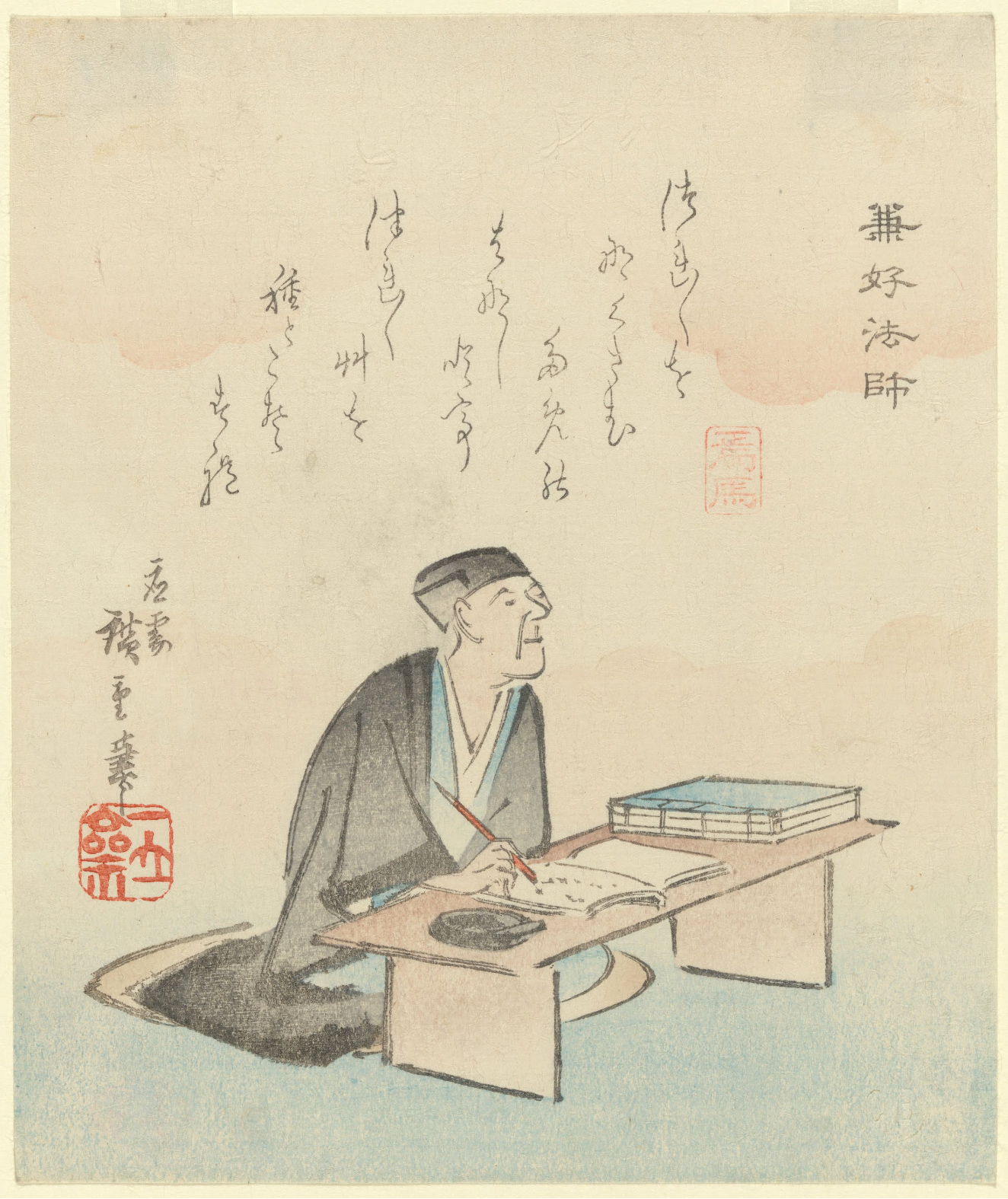Yoshida Kenkō on:
[Wikipedia]
[Google]
[Amazon]
, also known as , or simply , was a Japanese author and Buddhist monk. His most famous work is '' Tsurezuregusa'' (''Essays in Idleness''), one of the most studied works of
 Kenkō was probably born around 1283, as the son of an administration official. Forged documents by the
Kenkō was probably born around 1283, as the son of an administration official. Forged documents by the
Essays by Yoshida Kenko
a
Quotidiana.org
The Timeless Wisdom of Kenko
at
medieval Japanese literature
Japan's medieval period (the Kamakura period, Kamakura, Nanbokuchō period, Nanbokuchō and Muromachi period, Muromachi periods, and sometimes the Azuchi–Momoyama period) was a transitional period for the nation's literature. Kyoto ceased being ...
. Kenko wrote during the early Muromachi
The , also known as the , is a division of History of Japan, Japanese history running from approximately 1336 to 1573. The period marks the governance of the Ashikaga shogunate, Muromachi or Ashikaga shogunate ( or ), which was officially establ ...
and late Kamakura period
The is a period of History of Japan, Japanese history that marks the governance by the Kamakura shogunate, officially established in 1192 in Kamakura, Kanagawa, Kamakura by the first ''shōgun'' Minamoto no Yoritomo after the conclusion of the G ...
s.
Life and work
 Kenkō was probably born around 1283, as the son of an administration official. Forged documents by the
Kenkō was probably born around 1283, as the son of an administration official. Forged documents by the Yoshida Shinto
Yoshida (written: 吉田 lit. "lucky ricefield") is the 11th most common Japanese surname. A less common variant is 芳田 (lit. "fragrant ricefield").
Notable people with the surname
*Ai Yoshida, Japanese sailor
*, Japanese idol, singer and mo ...
authorities claimed that his original name was Urabe Kaneyoshi (卜部 兼好), and that his last name was later changed to Yoshida (吉田); all of this was recently demonstrated to be false, according to the latest research by Ogawa Takeo. ; see also 「卜部兼好伝批判−「兼好法師」から「吉田兼好」へ」(『国語国文研究』49号、2014年3月) He became an officer of guards at the Imperial palace. Later in life, he retired from public life and became a Buddhist monk and hermit
A hermit, also known as an eremite (adjectival form: hermitic or eremitic) or solitary, is a person who lives in seclusion. Eremitism plays a role in a variety of religions.
Description
In Christianity, the term was originally applied to a Chr ...
. The reasons for this are unknown, but it has been conjectured that it was either due to his unhappy love for the daughter of the prefect
Prefect (from the Latin ''praefectus'', substantive adjectival form of ''praeficere'': "put in front", meaning in charge) is a magisterial title of varying definition, but essentially refers to the leader of an administrative area.
A prefect' ...
of Iga Province
was a Provinces of Japan, province of Japan located in what is today part of western Mie Prefecture.Louis-Frédéric, Nussbaum, Louis-Frédéric. (2005). "Iga" in . Its abbreviated name was . Iga is classified as one of the provinces of the T� ...
, or his mourning over the death of Emperor Go-Uda that caused his transformation.
Although he also wrote poetry and entered some poetry contests at the imperial court (his participation in 1335 and 1344 is documented), Kenkō's enduring fame is based on ''Tsurezuregusa'', his collection of 243 short essays, published posthumously. Although traditionally translated as "Essays in Idleness," a more accurate translation would be "Notes from Leisure Hours" or "Leisure Hour Notes." Themes of the essays include the beauty of nature
Nature is an inherent character or constitution, particularly of the Ecosphere (planetary), ecosphere or the universe as a whole. In this general sense nature refers to the Scientific law, laws, elements and phenomenon, phenomena of the physic ...
, the transience and impermanence
Impermanence, also known as the philosophical problem of change, is a philosophical concept addressed in a variety of religions and philosophies. In Eastern philosophy it is notable for its role in the Buddhism, Buddhist three marks of existe ...
of life, traditions, friendship, and other abstract concepts. The work was written in the '' zuihitsu'' ("follow-the-brush") style, a type of stream-of-consciousness writing that allowed the writer's brush to skip from one topic to the next, led only by the direction of thoughts. Some are brief remarks of only a sentence or two; others recount a story over a few pages, often with discursive personal commentary added. Aside from his magnum opus
A masterpiece, , or ; ; ) is a creation that has been given much critical praise, especially one that is considered the greatest work of a person's career or a work of outstanding creativity, skill, profundity, or workmanship.
Historically, ...
''Tsurezuregusa'', another of his works is ''A Cup of Sake Beneath the Cherry Trees'', which is a compilation of reflections and essays of his thoughts, by which it primarily discusses about the fleeting pleasures of life.
The ''Tsurezuregusa'' was already popular in the 15th century and was considered a classic from the 17th century onwards. It is part of the modern Japanese high school curriculum, as well in some International Baccalaureate Diploma Programme
The International Baccalaureate Diploma Programme (IBDP) is a two-year educational programme primarily aimed at 16-to-19-year-olds in 140 countries around the world. The programme provides an internationally accepted qualification for entry int ...
schools.
See also
*Chance, Linda H. ''Formless in Form: Kenko,'' Tsurezuregusa, ''and the Rhetoric of Japanese Fragmentary Prose.'' Stanford UP, 1997. *Keene, Donald. ''Essays in Idleness: The'' Tsurezuregusa ''of Kenko.'' Columbia UP, 1967.References
External links
Essays by Yoshida Kenko
a
Quotidiana.org
The Timeless Wisdom of Kenko
at
Smithsonian_(magazine)
''Smithsonian'' is a magazine covering science, history, art, popular culture and innovation. The first issue was published in 1970.
History
The history of ''Smithsonian'' began when Edward K. Thompson, the retired editor of ''Life'' magazine ...
{{DEFAULTSORT:Yoshida, Kenko
1283 births
1352 deaths
Buddhist writers
Japanese essayists
Japanese hermits
Japanese Buddhist clergy
Buddhist clergy of the Kamakura period
14th-century Japanese philosophers